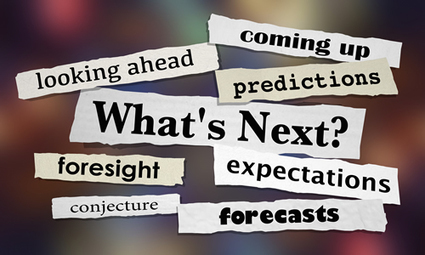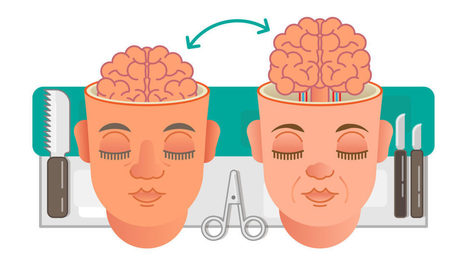 Your new post is loading...
 Your new post is loading...
The OfS blended learning report presents key strategic guidance for universities. With the momentum gained from the rapid transition to online learning, there is no better time to reimagine the student experience.
An increased focus on measuring learning, along with putting more thought into redesigning learning spaces, are two trends with great significance for higher ed in the next couple of years, according to the Horizon Report.
Here are six trends that will have wide-ranging impacts on higher education.
Today, Research England publishes three documents to help institutions prepare for the consultation later this month on the Knowledge Exchange Framework (KEF). One of those documents summarises the 106 responses to the December 2017 call for evidence, about what data is relevant to knowledge exchange and how it should be used appropriately. In particular, it looks at how institutions can be compared in a “fair and meaningful” way. The majority of responses are read as having a “cautiously positive tone, essentially this could be useful if done well”.
Good afternoon! A note about accessibility before I begin. If you would like to follow along with the written version of this talk, you can visit http://bit.ly/palakeynote. That link will also have the images on the slide deck with embedded descriptions for your screen reader, and the embedded video has closed captions.
I was really honored to be asked to keynote this luncheon for the Pennsylvania Library Association’s College and Research division at the PaLA annual conference… particularly because I fancy myself a parallel-universe librarian, and I know that out there through a wormhole somewhere, it is 1979 and I am using one of those thunk-thunk machines to date-stamp library book cards.
The university has developing digital capabilities as one of its core goals for the next five years. For instance, it has student digital champions who help others to develop the digital capabilities they might be expected to use in their course, such as e-portfolios, or WordPress as a website-creation tool.
Meanwhile, Harlow College claims that it has improved retention and achievement rates for students by making good use of digital technologies. For staff, it offers five cross-college development days where they can learn new digital skills. And there are 15-minute drop-in sessions where they can learn about new apps and tools and explore how they can use them in teaching.
In late October, Inside Higher Ed released its 2017 report on faculty attitudes and uses of technology. The report, a collaboration between Inside Higher Ed and Gallup, found that while faculty are warming up to technology, change is slow in the ivory tower and that many faculty continue to express concerns about public institutions partnering too closely with educational technology companies.
When you make the transition to university, one of the best resources that becomes available to you is the campus library system. Most universities have multiple libraries with extensive collections and generous hours of operation; the libraries at my school, the University of Waterloo, routinely stay open until midnight. Because campus libraries offer such a wealth of resources, many students aren’t motivated to explore the public libraries in their areas and may earn their entire degrees without ever setting foot in a community library. However, by not bothering to apply for a public library card, students are missing out on more than they realize. Here are just some of the reasons why you should make your local library a part of your university experience:
Technology is enabling more dynamic teaching and learning—both inside and outside of class.
Via Becky Roehrs
"How can universities and colleges best take advantage of the benefits that social media has to offer in our technology-heavy 21st century?"
Via EDTECH@UTRGV
Consuming information online is as simple as a click, scroll, or swipe these days. All searches are not created equal — and rarely do we think about fact checking what we find on the internet.
“…The internet is actually changing the way we read, the way we reason, and even the way we think, and all for the worse,” says Tom Nichols in his recently published book, The Death of Expertise.
In higher education, I think it is imperative that we teach our learners and peers about what it means to participate and interact in digital spaces and places. How can our institutions help students, staff, and faculty “be” online and consider how both information and digital environments impact knowledge sharing and learning.
At Digifest 2017, we announced a suite of new resources to help university and college leaders and staff make sure they have the digital skills they’ll need in their increasingly digital environment.
These resources include a digital capabilities discovery tool that will make it much simpler for individual staff – in many different job roles - and their managers to think clearly about their current digital capabilities, to identify skills gaps and create improvement pathways. The development of the discovery tool, and the resources that accompany it, is timely as digital capabilities climb higher up institutional agendas.
A number of forces are changing the world and the education you need to succeed in it. Is your university ready for the 21st century?
As the HE Bill heads to the House of Lords, Jonathan Woodhead of Birkbeck makes the case for Peers bringing part-time education to the forefront of the debate.
|
Participation in democracy, in today’s digital and datafied society, requires the development of a series of transversal skills, which should be fostered in higher education (HE) through critically oriented pedagogies that interweave technical data skills and practices together with information and media literacies. If students are to navigate the turbulent waters of data and algorithms, then data literacies must be featured in academic development programmes, thereby enabling HE to lead in the development of approaches to understanding and analysing data, in order to foster reflection on how data are constructed and operationalised across societies, and provide opportunities to learn from the analysis of data from a range of sources. The key strategy proposed is to adopt the use of open data as open educational resources in the context of problem and research-based learning activities. This paper introduces a conceptual analysis including an integrative overview of relevant literature, to provide a landscape perspective to support the development of academic training and curriculum design programmes in HE to contribute to civic participation and to the promotion of social justice.
Jisc has been a huge part of my personal and professional development. Jisc offers us access to a wealth of expertise and has created networks of professionals that would otherwise be unlikely to exist. But in the last year or so, I have begun to worry about what Jisc is becoming.
Like all things in the public sector, Jisc are having to reduce their costs and align to other external priorities. Which is likely one of the main reasons for the change in the organisation that are visible to those who work closest with it, and rely on it.
The ninth UCISA Survey of Technology Enhanced Learning (TEL) for higher education Report has been published. The Report offers a longitudinal perspective of TEL developments across the UK higher education sector, focusing on the current provision within universities and other higher education providers and the emerging and planned patterns of learning technology usage. This year’s Report draws on data going back to 2001 in its longitudinal analysis of TEL trends. In this blog post, we will explore some of the key findings from this year’s Survey, updating the picture that was reported on in 2016 (see corresponding blog post).
According to the recently published Natwest Student Living Index, 64% of university students rated the stress of studying for their degree as seven or above out of ten. Other studies have estimated that up to 82% of UK university students suffer from stress and anxiety, and the number of students dropping out of university due to mental health problems is increasing.
HEInnovate is a self-assessment tool for Higher Education Institutions who wish to explore their innovative potential. It guides you through a process of identification, prioritisation and action planning in seven key areas. HEInnovate also diagnoses areas of strengths and weaknesses, opens up discussion and debate on the entrepreneurial / innovative nature of your institution and it allows you to compare and contrast evolution over time. You can have instant access to your results, learning materials and a pool of experts.
Supporting student success: strategies for institutional change' is the final report to the What works? Student retention and success programme, a Paul Hamlyn Foundation initiative working with the Higher Education Academy, Action on Access and 13 UK universities across 43 discipline areas. The programme examined what works in terms of retention and success and, crucially, developed understanding about how to implement change.
The OER movement continues to have a significant impact on students, faculty, and the way teaching is occurring. OER can overcome barriers to students
Via Becky Roehrs
The opening provocation/keynote for #altc 2017, this talk examines open educational practices for a time of institutional decline & pervasive corporatism & sen…
Consuming information online is no more than a click, scroll, or swipe these days. All searches are not created equal and rarely do we think about fact checking what we find on the Internet. I am not alone in thinking about how “…the Internet is actually changing the way we read the way we reason, and even the way we think, and all for the worse” (The Death of Expertise, Nicols, 2017, p. 111). In higher education, I think it is imperative we teach our learners and colleagues about what it means to participate and interact in digital spaces and places. How can our institutions help students, staff, and faculty “be” online and consider how both information and digital environments impact knowledge sharing and learning?
As Claire Gray scans her customers’ shopping at the checkout in Waitrose in Wells, Somerset, she is imagining her future as a lawyer. In October, Gray, 46, will start juggling a part-time law degree at the Open University alongside her supermarket job. “I’m a bit nervous about studying,” she admits
National Guidelines for Improving Student Outcomes in Online Learning have been released by NCSEHE and University of Newcastle. There is also a Report detailing the research the guidelines are based on and Executive Summary.
E-learning encompasses not only technology but also pedagogical and instructional strategies to configure a complete learning environment based on the Internet. E-learning is nowadays widely used in higher education as a mean for supporting learning on academic programs. Concurrently, the Open Educational Resources (OER) are becoming a valuable alternative to improve access to high-quality educational content released under open licenses by outstanding universities worldwide. The conjunction of both concepts can configure a strategy to improve the quality of the curricula in the higher education institutions, particularly in development countries, in order to equalize the learning outcomes of international academic programs and to reduce the cost associated with educational content development. This work aims to achieve a preliminary understanding of the potential of the OER availability to be used in E-learning environments. As a case study, we have conducted an exploration of the feasibility of using OER to supplement E-learning environments for Higher Education in Computer Science at Ecuador. The search of the OER suitable to be used for this purpose has been performed on all categories of OER websites, including Open Courseware projects of prestigious universities. Moreover, this paper highlights the main barriers as well as the opportunities derived from adopting OER in E-learning environments.
|

 Your new post is loading...
Your new post is loading...
 Your new post is loading...
Your new post is loading...
































